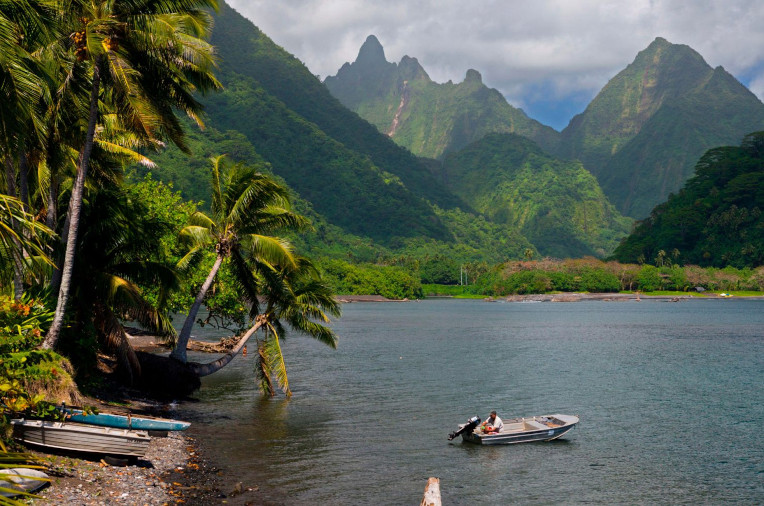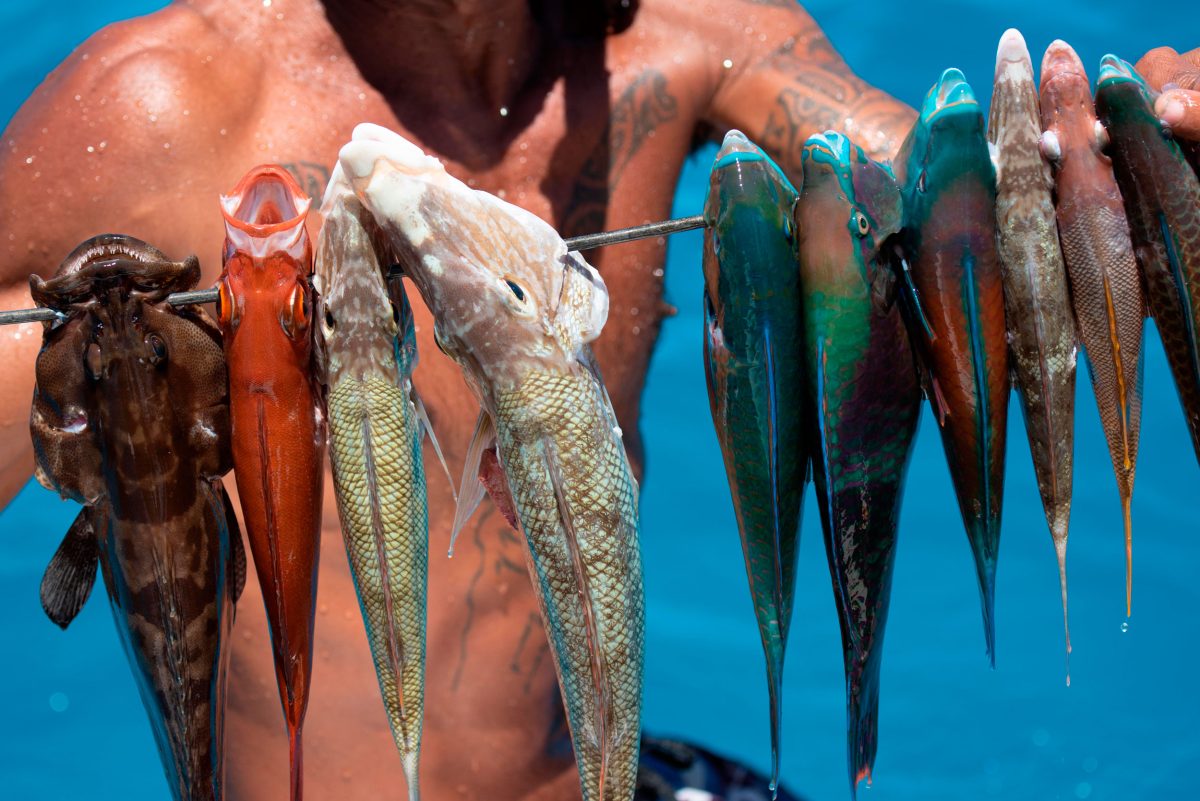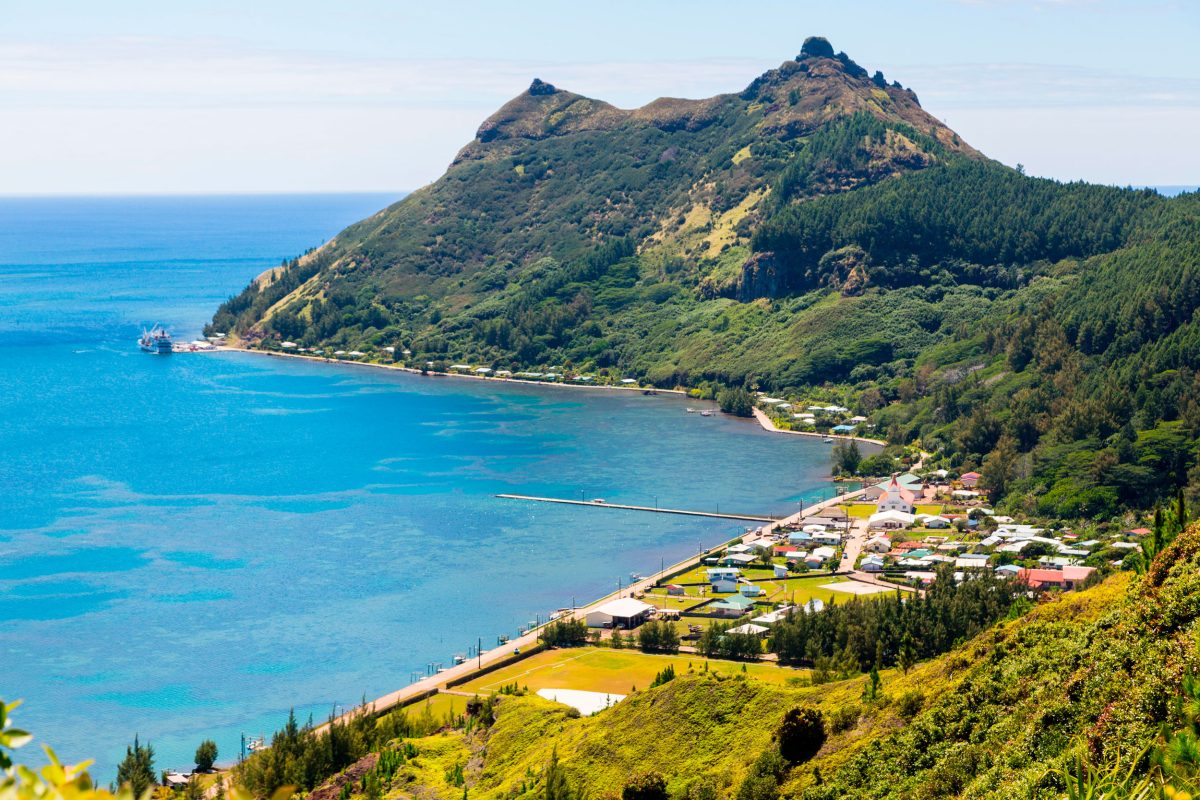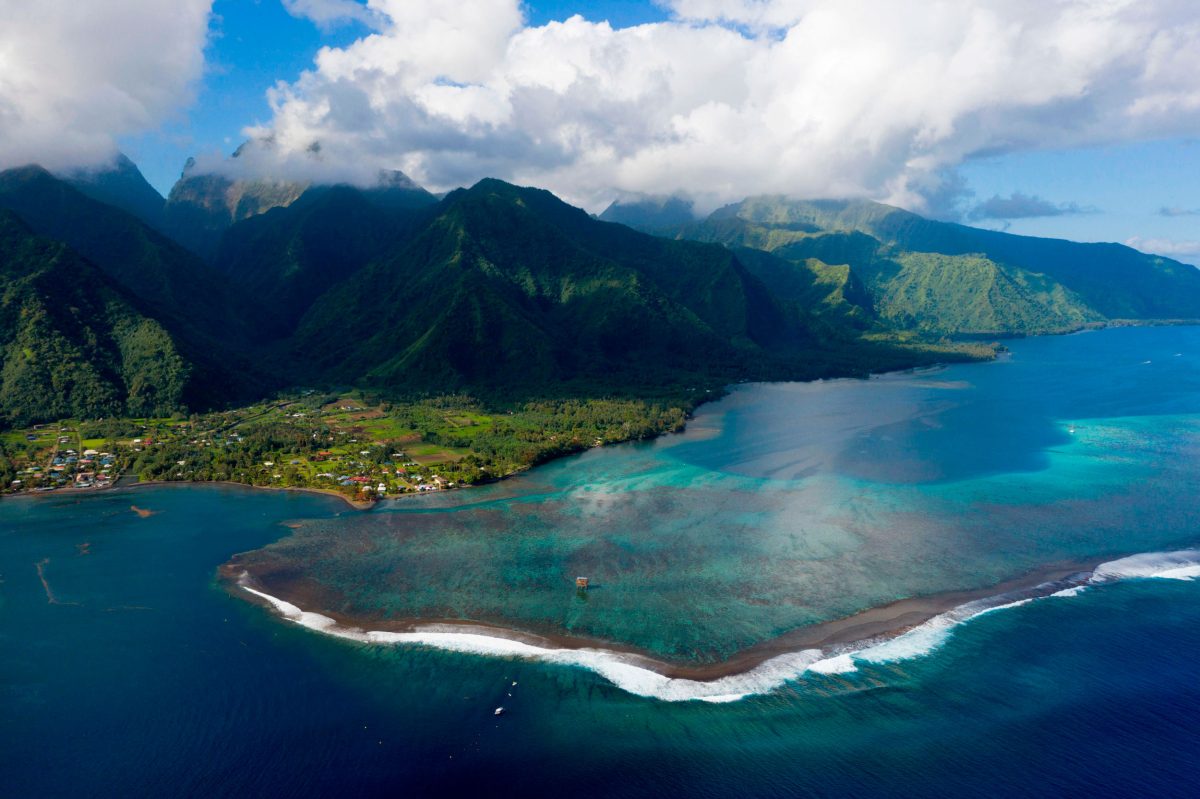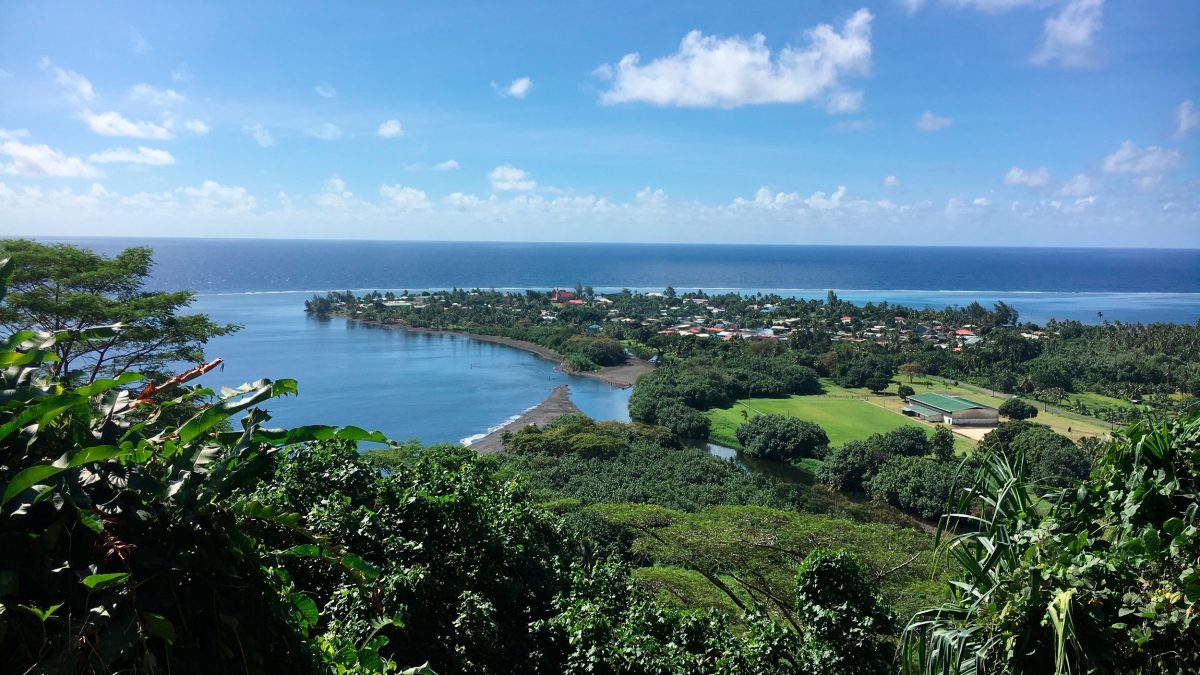Located in a quiet part of Tahiti, in French Polynesia, the village of Tautira sits on the ocean’s edge, framed by black sand beaches and a turquoise lagoon. With a population of just over 2,500, Tautira is known as the “village at the end of the road.” Beyond it is the island’s last truly wild coastline, accessible only on foot or by boat. Tautira is the kind of place where everyone is a “cousin,” “aunty,” or “uncle”; smiles are generous; and kids play soccer on the street. Some families here still live off the land, selling fish, fruits, and vegetables by the road to make ends meet.
On a balmy day in May 2023, for the first time in four years, the lagoon in Tautira saw the return of its apex predator. A group of about 50 local fishers, armed with fishing lines and spearguns, gathered at the marina at midday and pulled out coolers laden with their catches: crimson-red, bulging-eyed blotcheye soldierfish; green-and-blue-hued parrotfish the length of a man’s arm, and unicornfish with their distinctive hornlike noses. Over two mornings, the fishers caught around one tonne of fish—equal to more than 2,500 individual fish. Just five years ago, fishers would have been lucky to get that many fish in one week. The impressive catch was a testament to an ancient eastern Polynesian practice, known as rāhui, that might just be a key to developing sustainable, community-led solutions in Tahiti’s depleted coastal ecosystems.
A rāhui is, in essence, an area of land or water with a temporary limit on collecting a resource, such as a particular fish or fruit. In time, once the resource has had time to replenish, the rāhui is lifted. The word rāhui has many meanings in Polynesia. It can refer to a management system, a practice, a place, a belief, a law, or a lens through which related actions are assessed.
The concept of rāhui has existed in Polynesia—the more than 1,000 islands from New Zealand in the southwest, to Hawai‘i in the north, to Tahiti in the southeast—since before Europeans arrived in the South Pacific. These islands share similar languages and cultures and enjoy a long history of trade and connection.
French Polynesian fishers use fishing lines, nets, harpoons, and spearguns to harvest fish. The rāhui system restricts, or even prohibits, certain fishing methodologies in conservation zones. Photo by Pascale Gueret/Alamy Stock Photo (used with permission)
Yves Doudoute, Tahitian cultural expert and founding member of Haururu, an environmental conservation association, explains that in the Polynesian worldview, humans are an integral part of the natural environment:
“For our ancestors, the Earth was the first. She was our mother. She was even like a god. So you had to respect her.”
Many Polynesian legends speak to this sacred connection to the environment. In Māori mythology, Papatūānuku (earth mother) and Ranginui (sky father) are ancestors of all living things; to Native Hawaiians, the taro plant, Kalo, is their older brother; and all Polynesians consider that people, objects, or places can be imbued with mana, a kind of divine power or authority. A good leader, endowed with mana, had the power to create rāhui to manage resources.
Doudoute says that in the past, chiefs “were there to organize the management of everything. And so the rāhui was a form of management … but first, they would go to a god, to an all-powerful being, to intercede on their behalf, to help them in their endeavor.”
Divine authority sets the rāhui with the consent and collaboration of the people. It is a form of conservation, but it also serves many other, perhaps more important, purposes, such as to boost political power, strengthen community relationships, and reaffirm religious rituals. Rāhui is a fluid system that can adapt to different communities and perform a wide variety of functions.
Today, a resurgence of rāhui in Polynesia, such as the one initiated on Tautira in 2019, is showing how culturally sensitive conservation that engages locals has the potential to create lasting change. A 2019 study by the Pew Bertarelli Ocean Legacy Project found that 90 percent of inhabitants in French Polynesia support rāhui, much higher than the support for other legal conservation methods like protected marine areas.
The first modern rāhui in French Polynesia began on the island of Rapa, one of the most isolated islands in the Austral archipelago, accessible only by boat and with a population of around 500 people. On the island, fishing is one of the main sources of food and income.
By the early 1980s, local fishers and residents in Rapa had noticed that fish numbers were decreasing, and the fish themselves were getting smaller. New methods such as net fishing and the arrival of technologies such as freezers and motorized boats changed the way islanders interacted with the ocean. Lionel Watanabe, a former mayor, noted that by 1984, mullet fish had almost disappeared in the island’s main bay. Watanabe was inspired by a trip to Hawai‘i, where he visited Hanauma Bay Nature Reserve in Honolulu. The reserve had become an official marine-life conservation area with strict limits on fishing. Watanabe returned home determined to create something similar in Rapa.
The mayor decided to resurrect the old system of rāhui, but adapted to the modern day. Some local fishers were skeptical and pushed back. They argued against the plan, worried that the rāhui might affect their livelihoods. While the community knew that fish numbers had declined, everyone had their own opinion on how to tackle the problem. Countless hours of community meetings and compromises eventually led to an agreement, and a coastal rāhui was officially implemented in 1984, encompassing the island’s biggest bay, Ahurei. The entire bay became a closed zone, where spearfishing and night fishing were banned, but line and harpoon fishing—techniques considered more sustainable—were permitted. The community banned net fishing and cage trapping of lobsters everywhere, including in the “open zone” outside of the bay, where there were fewer restrictions.
One of the first modern-day revivals of the rāhui system in French Polynesia happened in Ahurei, on the island of Rapa, in the early 1980s. Photo by Dmitry Malov/Alamy Stock Photo (used with permission)
In 1986, the rāhui was opened temporarily with great success, and local fishers noticed a significant increase in fish and lobster numbers—enough to convince them that a sustained rāhui would continue to preserve fish numbers, and fish would always be available in the islands for generations to come. Although the islanders experienced firsthand the benefits of the rāhui zone, a 2014 National Geographic Society study confirmed that there were twice as many fish in the rāhui as in the open zone.
The Rapa rāhui remains in place today, and spearfishing restrictions are lifted temporarily just once or twice a year.
The success of the rāhui in Rapa and on other islands, such as Maïao, quickly caught on elsewhere in Polynesia. In Tahiti, a marine rāhui was created in 2014 in Teahupoo in the southwest region of the island. Within just a few years, researchers from the Center for Insular Research and Environmental Observatory (CRIOBE) in Moorea, French Polynesia, found that there was a significant increase in biomass in the rāhui zone—the average fish biomass was eight to 10 times higher than outside the rāhui.
Tamatoa Bambridge is a rāhui specialist and research director at the French National Centre for Scientific Research. He also led the scientific team monitoring the rāhui at Teahupoo and recalls the rise in biodiversity in 2017 as “incredible.” They discovered fish in the rāhui that were more than seven years old, attracted by the availability of food in the zone. Before the rāhui, overfishing meant that fish of that age and size were incredibly rare.
Today, French Polynesia has an estimated 20 or so rāhui on seven islands, and more are planned. Some, like Teahupoo, have seen great success, though Bambridge is quick to point out that many rāhui in the Pacific fail because of a lack of proper planning at the outset for the community to decide on techniques and limits they all agree on. Some rāhui even result in a notable decrease in fish biomass after the rāhui is lifted and fishing resumes: the fish increase at first, but then they become overfished.
In 2014, a rāhui was created in Teahupoo, in southwestern Tahiti, and depleted fish populations quickly recovered. Photo by Image Professionals GmbH/Alamy Stock Photo (used with permission.)
So, what does it take to implement a successful rāhui in the 21st century? Laure Vaitiare André is a researcher and expert in marine conservation and spatial planning in the Pacific. She says that involving locals in management is a key part of making a rāhui effective.
In Tautira, Rapa, and Teahupoo, community members are actively involved in maintaining the rāhui and enforcing the rules. The rāhui management committee in Tautira, for example, is made up of 10 people, including fishers, local government officials, church representatives, and community members, all of whom work together. They hold meetings whenever an issue comes up that requires discussion; this might be once every few months or twice a week, depending on the issue at hand.
Retiree Eric Pedupebe grew up in Tautira and is an active member of the rāhui management committee. He says that as community members go about their day, they watch for anyone who might be breaking the rāhui rules. If they see an infraction, they might talk to the person and inform them about the rāhui regulations or just let the committee know.
In addition, Pedupebe and a friend head into the rāhui zone at night during the new moon, but he says it can be difficult to find offenders. “There’s no light out there, there’s nothing … you really have to know your lagoon.” Pedupebe also says this kind of surveillance has limits, as he has no real power to stop people from fishing in the rāhui. It’s one of the issues discussed at committee meetings in an effort to find solutions.
Many rāhui in French Polynesia are also actively monitored by scientists. Marguerite Taiarui is a PhD candidate in tropical reef fisheries at CRIOBE and former fisheries manager of the Tautira rāhui. She studies the biological parameters of certain fish species and shares her results with the fishers and management committee. With these results and biomass estimates from the Rāhui Center, the management committee, managers from the Department of Marine Resources, and the community finalize a rāhui plan uniquely adapted to Tautira.
Taiarui says that, in the end, the committee decided to create a rāhui with three zones. The middle zone—the “heart”—remains closed, and the other two are open by rotation, in line with ancestral practices.
This kind of hybrid approach to marine management, combining local involvement and knowledge with modern scientific methods, is likely to increase success, according to marine conservation researcher André. “In this way, traditions can reinvent themselves to better meet the challenges of tomorrow,” she says.
In Tautira, many fishers pray before diving into the sea; together, on their poti marara, or Tahitian fishing boats, they gather, heads bowed, to ask for safety and an abundant catch. Polynesian spirituality and tradition are an integral part of rāhui, and this is where the approach stands apart from other conservation methods, such as regulated fishing zones. Traditional ceremonies, prayers, and stories are different, depending on local communities and their cultural beliefs. Bambridge points out a myth from the island of Raiatea, where two friends anger the god of the ocean, Ruahatu, by fishing in the wrong spot. They broke a rāhui, and Ruahatu, in his vengeance, flooded the island. Stories like this, passed down through generations, are warnings, but they also reinforce the respect that Polynesians have for institutions like rāhui.
The village of Tautira, Tahiti. Photo by Taerea/Shutterstock (used with permission)
Rāhui in French Polynesia are beginning to be recognized as a legitimate and effective way to preserve coastal ecosystems. The rāhui in Teahupoo has had legal protection under French Polynesia’s environmental law since 2016. And beginning in 2017, rāhui have been legally recognized as legitimate systems for conservation under the condition that they follow all state laws and regulations. Some rāhui also benefit from working in conjunction with official government-regulated fishing zones. The French Polynesian Department of Marine Resources has even integrated rāhui into its work in an effort to prevent overfishing and protect certain species.
Heremoana Maamaatuaiahutapu, the minister of culture, environment, and marine resources in French Polynesia, says that solutions need to be found now for issues like overfishing, marine pollution, and climate change. For island nations like French Polynesia, sustainable solutions are key. Maamaatuaiahutapu says,
“Today, it seems like the world in general always relies on scientific research to find solutions … but we also need to ask our elders. The first Polynesians arrived in the Pacific 4,000 years ago, and if we are still here today, it’s because we knew how to live and survive with our own solutions.”
Back on the island of Rapa, where the modern rāhui began, the rāhui opens temporarily every year. Fishers head to the rāhui zone and come back with a bounty big enough to feed the whole island, a feat that would be impossible on the bigger, more populous islands like Tahiti. The fish, most of them bigger than a football, are carefully laid out on the pier and divided into neat piles: one pile per family on the island. Just as in the old days, the food is shared equally. Just as in the old days, the rāhui ensures that a precious resource is maintained for generations to come.


